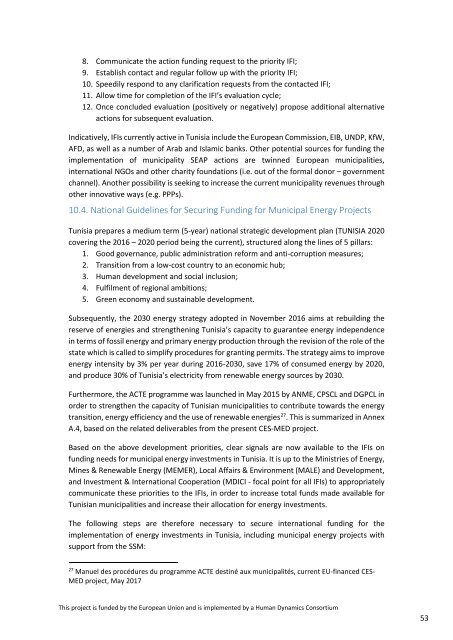311017_CESMED Funding_Mechanisms_Final
Create successful ePaper yourself
Turn your PDF publications into a flip-book with our unique Google optimized e-Paper software.
financing for this from CPSCL, the newly formed Fund for Energy Transition (FTE) 26 designed<br />
in the present CES-MED project for the Municipality Alliance for Energy Transition (ACTE)<br />
programme or other national sources. Alternative funding sources could be international<br />
donor or other IFI projects, e.g. similar to the present CES-MED or SUDEP projects by the<br />
European Commission.<br />
An indicative preliminary review / checklist of regional and local characteristics relevant to the<br />
preparation of a SEAP by a Tunisian municipality is presented in Annex A.1. The initial<br />
completion of this checklist will allow IFIs in particular to speedily understand and initially<br />
prioritise requests for funding the preparation of SEAPs from municipalities.<br />
10.3. Municipality <strong>Funding</strong> Guidelines for Implementation of SEAP Actions<br />
Once a municipality SEAP has been prepared, a good first step for this to gain international<br />
and also increase its national credibility is to be accepted by the European Commission,<br />
allowing the municipality to become a signatory of the CoM. It is noted that SEAPs have<br />
already been accepted from the Tunisian municipalities of Kairouan, Sfax and Sousse prepared<br />
through the present CES-MED project. Once included in a municipality’s SEAP as well as its PIC<br />
priority investments list, an action has good chances of being financed from national sources.<br />
It is however noted that some financially strong (from own sources) Tunisian municipalities<br />
do not receive any national funds towards the gradual implementation of their PIC.<br />
The next necessary step for each action included in the municipality SEAP is its elaboration in<br />
the form of a priority action fiche, e.g. as in the practical form applied in the present CES-MED<br />
project or in another more elaborate form developed for climate change projects, presented<br />
in Annexes A.2 and A.3 respectively. It is very important for municipalities to focus on their<br />
priority investments in order to develop their planning in more detail, rather than to embark<br />
on developing a large number of less well prepared investment proposals.<br />
The following subsequent steps are necessary for municipalities to secure alternative direct<br />
international funding for the implementation of each SEAP action, with support from a<br />
Tunisian SSM:<br />
1. Prepare SEAP with integrated set of medium term municipal energy actions and<br />
priority action fiches (e.g. on street lighting, energy efficiency in buildings, solar PV,<br />
urban travel or environmental mitigation as in the Tunisian CES-MED municipalities);<br />
2. Identify IFIs placing emphasis on financing the action’s type or technology in Tunisia<br />
(e.g. European Commission, EIB, UNDP, KfW, AFD) or the wider region;<br />
3. Check the type of support provided by each of the identified IFIs in Tunisia, i.e.<br />
Technical Assistance, grant, loans etc.;<br />
4. Select the IFIs providing the required type of support for each action type;<br />
5. Research the operations, specific active programme conditions and relevant future<br />
programme plans of each selected IFI;<br />
6. Prioritise the selected IFIs in terms of suitability for the specific action, level of support<br />
provided, total available budget for similar actions, strength of local contacts etc.;<br />
7. Develop a promotion plan for each action to the most suitable IFI;<br />
26<br />
Le mécanisme financier ACTE, current EU-financed CES-MED project, May 2017<br />
This project is funded by the European Union and is implemented by a Human Dynamics Consortium<br />
52

















